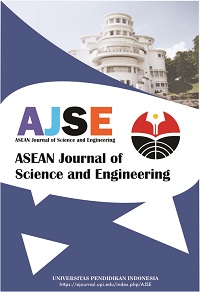Molecularly Imprinted Polymers for the Detection of Chlorpyrifos (an Organophosphate Pesticide)
Abstract
Keywords
Full Text:
PDFReferences
Arya, A. K., Singh, A., and Bhatt, D. (2019). Pesticide applications in agriculture and their effects on birds: an overview. Contaminants in Agriculture and Environment: Health Risks and Remediation, 5(10), 130-137.
Ayankojo, A. G., Reut, J., Öpik, A., Furchner, A., and Syritski, V. (2018). Hybrid molecularly imprinted polymer for amoxicillin detection. Biosensors and Bioelectronics, 118, 102-107.
Azizah, N. N., Maryanti, R., and Nandiyanto, A. B. D. (2021). How to search and manage references with a specific referencing style using google scholar: From step-by-step processing for users to the practical examples in the referencing education. Indonesian Journal of Multidiciplinary Research, 1(2), 267-294.
Chawla, P., Kaushik, R., Swaraj, V.S., and Kumar, N. (2018). Organophosphorus pesticides residues in food and their colorimetric detection. Environmental Nanotechnology, Monitoring and Management, 10, 292-307.
Cieplak, M., Szwabinska, K., Sosnowska, M., Chandra, B.K., Borowicz, P., Noworyta, K., D’Souza, F., and Kutner, W. (2015). Selective electrochemical sensing of human serum albumin by semi-covalent molecular imprinting. Biosensors and Bioelectronics, 74, 960-966.
Copplestone, J.F. (1988). The development of the WHO Recommended Classification of Pesticides by Hazard. Bulletin of the World Health Organization, 66, 545.
Costa, L.G., Giordano, G., Guizzetti, M., and Vitalone, A. (2008). Neurotoxicity of pesticides: a brief review. Frontiers in Bioscience, 13, 1240-1249.
Fang, L., Jia, M., Zhao, H., Kang, L., Shi, L., Zhou, L., and Kong, W. (2021a). Molecularly imprinted polymer-based optical sensors for pesticides in foods: Recent advances and future trends. Trends in Food Science and Technology, 116, 387-404.
Fang, L., Miao, Y., Wei, D., Zhang, Y., and Zhou, Y. (2021b). Efficient removal of norfloxacin in water using magnetic molecularly imprinted polymer. Chemosphere, 262, 128032.
Farag, A.T., Radwan, A.H., Sorour, F., El Okazy, A., El-Agamy, E.-S., and El-Sebae, A.E.-K. (2010). Chlorpyrifos induced reproductive toxicity in male mice. Reproductive Toxicology, 29, 80-85.
Foroughirad, S., Haddadi-Asl, V., Khosravi, A., and Salami-Kalajahi, M. (2021). Effect of porogenic solvent in synthesis of mesoporous and microporous molecularly imprinted polymer based on magnetic halloysite nanotubes. Materials Today Communications, 26, 101780.
Ghorab, M.A., and Khalil, M.S. (2015). Toxicological effects of organophosphates pesticides. International Journal of Environmental Monitoring and Analysis, 3, 218-220.
Hassaan, M. A., and El Nemr, A. (2020). Pesticides pollution: Classifications, human health impact, extraction and treatment techniques. The Egyptian Journal of Aquatic Research, 46(3), 207-220.
Huang, W., Zhou, X., Luan, Y., Cao, Y., Wang, N., Lu, Y., Liu, T., and Xu, W. (2020). A sensitive electrochemical sensor modified with multi‐walled carbon nanotubes doped molecularly imprinted silica nanospheres for detecting chlorpyrifos. Journal of Separation Science, 43, 954-961.
Islam, S., Shukla, S., Bajpai, V.K., Han, Y.-K., Huh, Y.S., Ghosh, A., Gandhi, S. (2019). Microfluidic-based graphene field effect transistor for femtomolar detection of chlorpyrifos. Scientific Reports, 9, 1-7.
Jayaraj, R., Megha, P., and Sreedev, P. (2016). Organochlorine pesticides, their toxic effects on living organisms and their fate in the environment. Interdisciplinary Toxicology, 9, 90.
Jenkins, A.L., Yin, R., and Jensen, J.L. (2001). Molecularly imprinted polymer sensors for pesticide and insecticide detection in water. Analyst, 126, 798-802.
Jiang, Y., David, B., Tu, P., and Barbin, Y. (2010). Recent analytical approaches in quality control of traditional Chinese medicines—a review. Analytica Chimica Acta, 657, 9-18.
Jiao, Y., Hou, W., Fu, J., Guo, Y., Sun, X., Wang, X., and Zhao, J. (2017). A nanostructured electrochemical aptasensor for highly sensitive detection of chlorpyrifos. Sensors and Actuators B: Chemical, 243, 1164-1170.
KANKAM, F. (2021). Causes and management of pesticides contamination in agriculture: A review. Ghana Journal of Science, 7(2), 2.
Kaur, R., Mavi, G. K., Raghav, S., and Khan, I. (2019). Pesticides classification and its impact on environment. International Journal of Current Microbiology and Applied Sciences, 8(3), 1889-1897.
Kim, K.-S., Lee, J.-H., Kim, M.H., and Cho, S.-H. (2005). Preparation and characterization of molecularly imprinted uniform-sized Poly (4VP-co-EGDMA) microgels. Polymer Journal, 37, 669-676.
Lewis, R., Fortmann, R., and Camann, D. (1994). Evaluation of methods for monitoring the potential exposure of small children to pesticides in the residential environment. Archives of Environmental Contamination and Toxicology, 26, 37-46.
Li, W., Zhang, X., Li, T., Ji, Y., and Li, R. (2021). Molecularly imprinted polymer-enhanced biomimetic paper-based analytical devices: A review. Analytica Chimica Acta, 1148, 238196.
Mogha, N.K., Sahu, V., Sharma, M., Sharma, R.K., and Masram, D.T. (2016). Biocompatible ZrO2-reduced graphene oxide immobilized AChE biosensor for chlorpyrifos detection. Materials and Design, 111, 312-320.
Mosbach, K. (1994). Molecular imprinting. Trends in Biochemical Sciences, 19, 9-14.
Mustaghfiroh, A.M., Mulyasuryani, A., and Andayani, U. (2019). Development of chlorpyrifos sensor using molecularly imprinted polymer (mip) polyvinyl alcohol (PVA)-Fe3O4 as receptor. The Journal of Pure and Applied Chemistry Research, 8, 31-39.
Nicholls, I.A., Andersson, H.S., Charlton, C., Henschel, H., Karlsson, B.C., Karlsson, J.G., O’Mahony, J., Rosengren, A.M., Rosengren, K.J., and Wikman, S. (2009). Theoretical and computational strategies for rational molecularly imprinted polymer design. Biosensors and Bioelectronics, 25, 543-552.
Nsibande, S., and Forbes, P. (2016). Fluorescence detection of pesticides using quantum dot materials–a review. Analytica Chimica Acta, 945, 9-22.
Ren, X., Liu, H., and Chen, L. (2015). Fluorescent detection of chlorpyrifos using Mn (II)-doped ZnS quantum dots coated with a molecularly imprinted polymer. Microchimica Acta, 182, 193-200.
Ridano, M.E., Racca, A.C., Flores-Martin, J.B., Fretes, R., Bandeira, C., Reyna, L., Bevilacqua, E., Genti-Raimondi, S., and Panzetta-Dutari, G. (2017). Impact of chlorpyrifos on human villous trophoblasts and chorionic villi. Toxicology and Applied Pharmacology, 329, 26-39.
Samsidar, A., Siddiquee, S., and Shaarani, S. M. (2018). A review of extraction, analytical and advanced methods for determination of pesticides in environment and foodstuffs. Trends in Food Science and Technology, 71, 188-201.
Saylan, Y., Akgönüllü, S., Yavuz, H., Ünal, S., and Denizli, A. (2019). Molecularly imprinted polymer based sensors for medical applications. Sensors ,19, 1279.
Sharma, A., Shukla, A., Attri, K., Kumar, M., Kumar, P., Suttee, A., Singh, G., Barnwal, R.P., and Singla, N. (2020). Global trends in pesticides: A looming threat and viable alternatives. Ecotoxicology and Environmental Safety, 201, 110812.
Sheppard, L., McGrew, S., and Fenske, R.A. (2020). Flawed analysis of an intentional human dosing study and its impact on chlorpyrifos risk assessments. Environment International, 143, 105905.
So, J., Ahn, J., Lee, T.-H., Park, K.-H., Paik, M.-K., Jeong, M., Cho, M.-H., and Jeong, S.-H. (2014). Comparison of international guidelines of dermal absorption tests used in pesticides exposure assessment for operators. Toxicological Research, 30, 251-260.
Sun, X., Gao, C., Zhang, L., Yan, M., Yu, J., and Ge, S. (2017). Photoelectrochemical sensor based on molecularly imprinted film modified hierarchical branched titanium dioxide nanorods for chlorpyrifos detection. Sensors and Actuators B: Chemical, 251, 1-8.
Talan, A., Mishra, A., Eremin, S.A., Narang, J., Kumar, A., and Gandhi, S. (2018). Ultrasensitive electrochemical immuno-sensing platform based on gold nanoparticles triggering chlorpyrifos detection in fruits and vegetables. Biosensors and Bioelectronics, 105, 14-21.
Umar, A.M., and Aisami, A. (2020). Acetylcholinesterase enzyme (AChE) as a biosensor and biomarker for pesticides: A mini review. Bulletin of Environmental Science and Sustainable Management (e-ISSN 2716-5353), 4, 7-12.
Uzun, L., and Turner, A.P. (2016). Molecularly-imprinted polymer sensors: Realising their potential. Biosensors and Bioelectronics, 76, 131-144.
Van Dyk, J.S., and Pletschke, B. (2011). Review on the use of enzymes for the detection of organochlorine, organophosphate and carbamate pesticides in the environment. Chemosphere, 82, 291-307.
Wackerlig, J., and Schirhagl, R. (2016). Applications of molecularly imprinted polymer nanoparticles and their advances toward industrial use: a review. Analytical Chemistry, 88, 250-261.
Xie, C., Li, H., Li, S., and Gao, S. (2011). Surface molecular imprinting for chemiluminescence detection of the organophosphate pesticide chlorpyrifos. Microchimica Acta, 174, 311.
Xing, R., Wang, S., Bie, Z., He, H., and Liu, Z. (2017). Preparation of molecularly imprinted polymers specific to glycoproteins, glycans and monosaccharides via boronate affinity controllable–oriented surface imprinting. Nature Protocols, 12, 964-987.
Yadav, I.C., and Devi, N.L. (2017). Pesticides classification and its impact on human and environment. Environmental Science and Engineering, 6, 140-158.
Yan, H., and Row, K.H. (2006). Characteristic and synthetic approach of molecularly imprinted polymer. International Journal of Molecular Sciences, 7, 155-178.
Zhao, Q., Dourson, M., and Gadagbui, B. (2006). A review of the reference dose for chlorpyrifos. Regulatory Toxicology and Pharmacology, 44, 111-124.
Zhu, J., Agyekum, A.A., Kutsanedzie, F.Y., Li, H., Chen, Q., Ouyang, Q., and Jiang, H. (2018). Qualitative and quantitative analysis of chlorpyrifos residues in tea by surface-enhanced Raman spectroscopy (SERS) combined with chemometric models. Lebensmittel-Wissenschaft and Technologie (LWT), 97, 760-769.
DOI: https://doi.org/10.17509/ajse.v2i3.41351
Refbacks
- There are currently no refbacks.
Copyright (c) 2021 Universitas Pendidikan Indonesia

This work is licensed under a Creative Commons Attribution-ShareAlike 4.0 International License.












